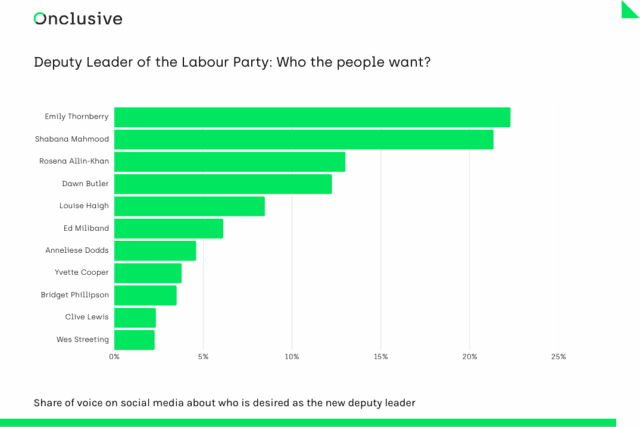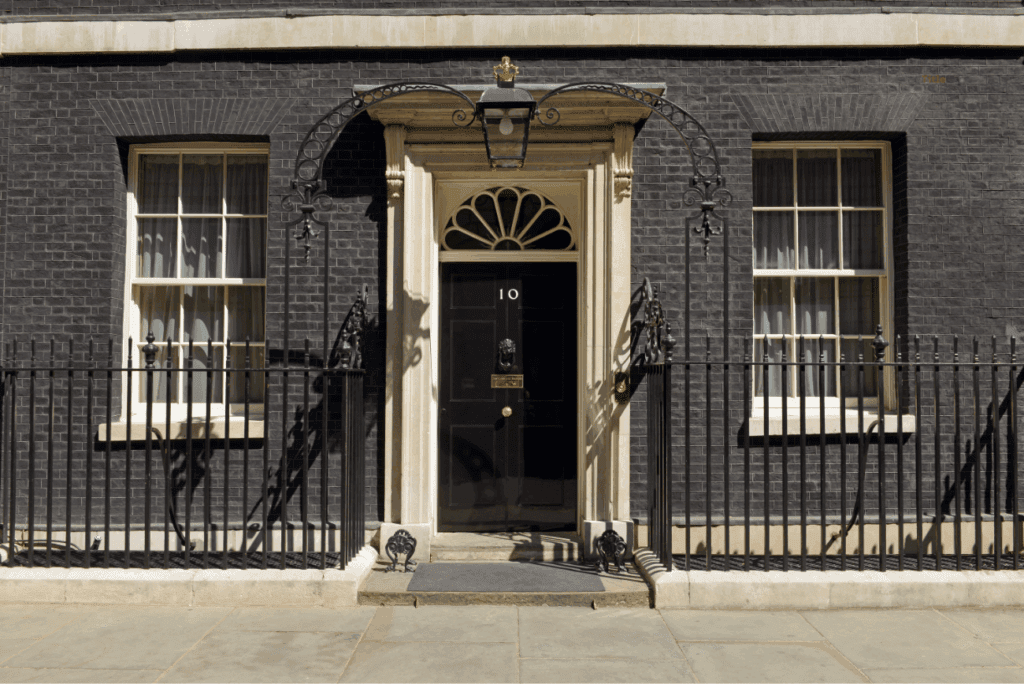Angela Rayner’s shock resignation didn’t just shake Westminster- it lit up social media with over 300,000 mentions in 48 hours. Here’s how the Deputy Leadership Race exploded online, and who the public are talking about as her successor and how people are reacting to Rayner’s resignation on social media.
I. Rayner’s Exit Sparks Firestorm: Social Media Erupts and Headlines Blaze Over Labour’s Reshuffle
I. Rayner’s Exit Sparks Firestorm: Social Media Erupts and Headlines Blaze Over Labour’s Reshuffle
The data from Onclusive provides a snapshot of the intense public and media scrutiny surrounding Angela Rayner’s resignation on September 5, 2025, as Deputy Prime Minister, Housing Secretary, and Deputy Leader of the Labour Party, alongside the subsequent cabinet reshuffle under Prime Minister Keir Starmer.
This event, triggered by allegations of tax irregularities related to her property dealings, has clearly resonated widely, amplifying discussions about Labour’s internal stability, ethical standards, and leadership dynamics. Below, I’ll break down the key metrics, explain their implications, and contextualize them within the broader political landscape as of September 8, 2025.

Social Media Metrics: 305K mentions from Friday 5 to Sunday 7 September (via Onclusive tools)
1. Social Media Metrics: Explosive Engagement with Polarized Reach
305K mentions from Friday 5 to Sunday 7 September:
This volume indicates a rapid surge in conversation, likely peaking immediately after the resignation announcement on Friday. For context, this is extraordinarily high for a single political event in the UK, surpassing typical coverage of routine cabinet changes and rivaling major scandals like the 2022 Partygate revelations (which saw around 200K-250K daily mentions at their height). The mentions reflect real-time reactions, including speculation on replacements (e.g., for Rayner in housing and deputy roles), Starmer’s handling of the crisis, and broader critiques of Labour’s “sleaze” narrative.
Reach of 109 million:
This metric measures the potential audience exposed to these posts (e.g., via views, shares, and algorithms on platforms like X/Twitter, Facebook, and Instagram). It’s a staggering figure, equivalent to about 1.5 times the UK adult population, suggesting viral amplification through influencers, politicians, and media shares. Right-wing accounts (e.g., from Reform UK supporters) and centrist critics drove much of this, celebrating the resignation as “accountability,” while Labour loyalists and progressives countered with defenses against “classist” attacks. The high reach underscores how social media can exacerbate political polarization, turning a niche policy scandal into a national talking point.
177K people talking about it:
This represents unique voices contributing, from everyday users to high-profile figures like Nigel Farage (who used it to bash Labour at his conference) and Labour MPs. The diversity of participants highlights grassroots involvement, but also the risk of echo chambers—left-leaning users (e.g., union affiliates) focused on misogyny and media bias, while others amplified calls for Starmer’s resignation. Notably, this engagement tapered slightly over the weekend, but the reshuffle announcements (e.g., potential promotions for figures like Wes Streeting or Shabana Mahmood) likely sustained momentum into Monday.
David Lammy’s Prominence:
The 80,000 mentions of David Lammy (approximately 26% of total mentions) highlight his central role in the reshuffle narrative. His appointment as Deputy Prime Minister, a high-profile position, likely drove significant discussion, especially given his previous role as Foreign Secretary and his public profile. These mentions likely include both praise for his elevation and criticism, particularly from opposition figures like Nigel Farage and Kemi Badenoch, who used the reshuffle to attack Labour’s stability.
2. Mainstream Media Metrics: Sustained but Less Frenzied Coverage
- 11,010 mentions from Friday 5 to Sunday 8 September: Spanning digital (e.g., BBC News, Guardian websites), print (e.g., Sunday Times, Observer), TV (e.g., BBC Breakfast, Sky News specials), and radio (e.g., LBC phone-ins), this is a robust but more measured volume compared to social media. It equates to hundreds of articles, segments, and bulletins daily, far exceeding coverage of minor reshuffles (e.g., the 2024 post-election one had under 5K mentions). The extension to Sunday 8 captures weekend analysis, including op-eds on Labour’s “humiliation” and ethical reforms. Outlets like The Telegraph and Mail leaned critical, framing it as Rayner’s “fall from grace,” while The Guardian emphasized systemic biases against working-class women in politics.
- David Lammy’s Share: The 2,613 mentions of Lammy (about 24% of total mentions) align closely with his social media prominence (26%), suggesting consistent focus across both spheres. His appointment as Deputy Prime Minister and Justice Secretary was a headline-grabbing move, with outlets like BBC News, Reuters, and The Mirror emphasizing his role in Starmer’s “reset” of the government. Coverage likely highlighted his shift from Foreign Secretary and his pledge to make Britain “fairer, safer, and better off” (as per his X post).
- Media Narrative: Mainstream media framed the resignation as a “devastating blow” (BBC’s Henry Zeffman) and a “crisis” for Labour (The Guardian, Financial Times). Reports detailed the reshuffle’s key moves: Yvette Cooper to Foreign Secretary, Shabana Mahmood to Home Secretary, and Steve Reed to Housing Secretary. Outlets like The Daily Mail described Labour as “in meltdown,” while The Independent noted Starmer’s attempt to “reclaim the narrative.” The coverage also highlighted sacked ministers (Lucy Powell, Ian Murray) and emerging figures like Darren Jones, who took on a “super ministry.”
II. Deputy Leader of the Labour Party: Who the people want?
Based on recent social media discussions from September 5-8, 2025, following Angela Rayner’s resignation as Deputy Leader of the Labour Party, public sentiment and speculation about her replacement are highly varied and often partisan. The role is an elected position, decided by Labour members, affiliates, and unions after nominations, so much of the online buzz revolves around floated candidates, potential runners, and preferences from different party factions. There’s no clear consensus “winner” in terms of overwhelming public demand, but certain names dominate the conversation, with a mix of support, criticism, and humor. Left-leaning users often advocate for progressive or “soft left” figures to counter Starmer’s perceived rightward shift, while moderates and critics push for centrist options. Right-wing commentators frequently mock the prospects or predict party chaos.

Share of voice on social media about who is desired as the new deputy leader (via Onclusive Social tool).
Here’s a breakdown of the most frequently mentioned candidates, ranked by volume of mentions in relevant posts, along with key themes in reactions:
Emily Thornberry (Most discussed overall)
Thornberry, a veteran MP and former Shadow Foreign Secretary, emerges as the frontrunner in social media speculation, with users sharing reports of her preparing to run or considering a bid. Supporters praise her experience and confidence in broadening Labour’s appeal, as seen in BBC interviews where she emphasized listening to a “wider group of people.” However, critics—especially from the right—ridicule her as “over-entitled” or highlight past controversies like her 2014 tweet mocking a white van with England flags, viewing her as a “hard left” risk or out-of-touch. Some see her as a pragmatic choice for Starmer, though optics of a “Sir Keir and Dame Emily” duo are questioned for appealing to working-class voters. She’s floated in left-leaning and soft-left contexts, with one user noting her potential in a contest that could benefit that wing.
Shabana Mahmood (Popular among moderates and Starmer allies)
As Justice Secretary, Mahmood is frequently tipped as an interim or permanent replacement, with reports of Starmer encouraging her to stand. Users highlight her rising stock, competence, and ability to unify factions, positioning her as a “loyalist” or “safe pair of hands” for stability. She’s seen as a moderate choice to rally support against left-wing challengers, though some left-leaning posts express wariness about her alignment with Starmer’s direction.
Rosena Allin-Khan (Favored by left-wing and progressive voices)
Allin-Khan, a backbench MP and NHS doctor, is floated as a “fresh” left-wing or soft-left option, appealing to those seeking diversity and grassroots energy. Supporters value her mental health advocacy and shadow cabinet experience, but critics dismiss her as “abrasive” or part of the party’s internal opposition.
Dawn Butler (Mentioned in left-wing contexts, but polarizing)
Butler is suggested as a left-wing candidate, often alongside Allin-Khan, with emphasis on her focus on race and social justice. However, reactions are mixed; some users criticize her as overly divisive or “abrasive,” suggesting a “Red Wall” MP instead for broader appeal.
Louise Haigh (Emerging as a potential riser)
Haigh, the Transport Secretary, is mentioned as a soft-left contender with “a lot of potential,” praised for her policy track record. She’s seen as ambitious but faces jabs over past issues, like one user calling her a “fraudster” in sarcasm.
Ed Miliband
Posts from Labour supporters, such as @LabourList, highlight Miliband’s popularity and his potential to “steady the ship” as Deputy Leader. Users appreciate his experience and alignment with the party’s core values, with some (@MomentumUK) calling for a “return to the left” under his influence. However, his past leadership tenure (2010–2015) draws mixed reactions, with some users questioning his electability due to Labour’s 2015 loss under him.
Anneliese Dodds
Mentions of Dodds are sparse, but where present, they come from left-leaning users who admire her resignation as a stand against Starmer’s policies (@LeftFootForward). Her lower profile limits widespread discussion, and she lacks the visibility of Thornberry or Miliband.
Yvette Cooper
The overwhelming majority of posts tie Cooper to the cabinet reshuffle, where she’s moved to Foreign Secretary—a role users often frame as a “rise” or “step up.” Some left-leaning voices express optimism about her trajectory, suggesting she’s “eyeing the top job” (Prime Minister) and could become Britain’s first female Labour PM, potentially via Chancellor next. This positions her more as a leadership contender than specifically for Deputy Leader.
Other Notable Mentions
Bridget Phillipson: Tipped as a “loyalist” choice for continuity, with odds listed in betting speculation.
Clive Lewis: Advocated by left-leaning users like Peter Tatchell as a progressive to reverse Labour’s “rightward drift.”
Wes Streeting: he was more often cited for Deputy PM than Deputy Leader, but some crossover as a “rising star” with charisma.
Fringe or critical suggestions: Hard-left figures like Richard Burgon or John McDonnell for disruption; humorous outsiders like Susan Hall (a Tory, clearly satirical).
Overall, the discourse is speculative and contentious, with users warning of a “shitshow” or “civil war” in the election process. Left-wing posters emphasize member choice to push back against Starmer, while others predict a parade of candidates at Labour conference. Sentiment leans toward Thornberry as the “people’s” buzz candidate due to sheer volume, but with significant backlash; moderates favor Mahmood for unity. These insights are drawn from a sample of high-engagement posts and may evolve as nominations formalize.
III. Rayner’s Resignation Ignites Reactions: Social Media Frenzy and Mainstream Media Storm Over Labour’s Reshuffle
-
Social Media Reactions: Sentiment and Key Themes:
Support for Rayner:
Labour figures expressed strong support for Rayner. Wes Streeting (Health Secretary) posted on X, praising her as a “trailblazer for working class kids” . They highlighting her achievements in council housing and workers’ rights, emphasizing their 20-year friendship. Darren Jones called her the “embodiment of social mobility,” crediting her housing and labor reforms. Lisa Nandy (Culture Secretary) described Rayner as a “force for good”, lamenting her departure.
Trade union Usdaw expressed sadness, noting Rayner’s role as a champion for workers’ rights. Some Labour supporters, echoed by a Savanta poll (56% of Labour voters saw the allegations as a smear campaign), defended Rayner. They arguing she was targeted by right-wing media for her working-class background.
Posts on social media, such as one from @TheNewsAgents, acknowledged sympathy for Rayner, with comments like “yes she should’ve done better – but it doesn’t equate to what we saw in the last gov’t with people on the make”.
Criticism and Opposition Attacks:
Nigel Farage (Reform UK leader) capitalized on the resignation, moving his party conference speech forward to address it, stating that Labour was “deep in crisis” and “not fit to govern” (@BBCPolitics). He framed Rayner’s £40,000 stamp duty underpayment as evidence of Labour’s hypocrisy, resonating with Reform UK supporters who booed Lammy’s appointment at their Birmingham conference.
Kemi Badenoch (Conservative leader) posted that Rayner’s position was “untenable for days” and criticized Starmer’s “weak leadership” for not sacking her sooner, accusing her of tax evasion and lying (@BBCPolitics). Her comments fueled hashtags like #LabourSleaze, which trended briefly on X.
Some social media users labeled Rayner’s actions as “revolting greed & scheming,” reflecting a segment of public anger over the tax scandal.
Mixed Reactions and Analysis:
Graham Stringer (Labour MP) expressed sadness but called Rayner’s resignation “inevitable” after her admission of error, reflecting a pragmatic view among some Labour MPs.
Political commentators, such as @BBCPolitics, noted the reshuffle as a “reset” but a “gift for Reform UK,” with Laura Kuenssberg highlighting Labour’s turmoil (@BBCPolitics). Others described the resignation as a “devastating blow” for Starmer, emphasizing Rayner’s role as a working-class voice and party unifier (@BBCPolitics).
Public sentiment on social media was polarized. Some users sympathized with Rayner, citing the media’s toll on her family, particularly her disabled son’s trust, which complicated her tax affairs. Others criticized her hypocrisy, given her past attacks on Tory tax scandals, with posts referencing a viral YouTube video (1.5 million views) of Rayner dancing, used to mock her.
Reshuffle Reactions:
The reshuffle, with David Lammy as Deputy Prime Minister and Justice Secretary, Yvette Cooper as Foreign Secretary, and Shabana Mahmood as Home Secretary, drew mixed responses. Lammy’s appointment was met with boos at Reform UK’s conference, reflecting partisan opposition. Supporters praised his loyalty to Starmer, while critics questioned his demotion from Foreign Secretary.
Cooper’s move to Foreign Secretary was seen as a promotion, but her failure to curb small boat crossings as Home Secretary drew scrutiny. Mahmood’s new role was noted for its challenges, with posts highlighting her upcoming Five Eyes talks on immigration.
The sacking of Lucy Powell and Ian Murray sparked debate, with some users viewing it as Starmer clearing out underperformers, while others saw it as destabilizing.
2. Mainstream Media Reactions: Key Themes
Rayner’s Resignation as a Crisis:
-
- Outlets like The Guardian described Labour as “engulfed” in a crisis, with Rayner’s exit a “serious blow” due to her role as a working-class voice and party unifier. BBC News called it a “devastating blow” for Starmer, noting her popularity among backbenchers.
- The Daily Mail framed Labour as “in meltdown,” emphasizing the sleaze inquiry and Rayner’s £40,000 stamp duty underpayment on a Hove flat. The ethics adviser, Sir Laurie Magnus, concluded Rayner breached the ministerial code by not seeking specialist tax advice, despite acting in “good faith”.
- Coverage highlighted the personal toll, with Rayner citing media scrutiny on her family, particularly her disabled son’s trust, as a factor in her decision. Some outlets, like The Guardian, noted sympathy for Rayner due to the complex tax system, with tax expert Dan Neidle calling stamp duty “messy”.
Reshuffle as a Reset Attempt:
- The reshuffle was described as Starmer’s attempt to “restore order” and “draw a line” under the scandal. Key moves included:
- David Lammy as Deputy Prime Minister and Justice Secretary, seen as a loyalist promotion but also a demotion from Foreign Secretary.
- Yvette Cooper as Foreign Secretary, a move framed as a promotion but complicated by her struggles with small boat crossings.
- Shabana Mahmood as Home Secretary, tasked with immigration challenges, with outlets noting her “no-nonsense” reputation.
- Steve Reed as Housing Secretary, taking on Labour’s 1.5 million homes pledge.
- The Financial Times and BBC noted the historic milestone of women (Cooper, Mahmood, and Chancellor Rachel Reeves) holding the three great offices of state (;).
- Sackings of Lucy Powell and Ian Murray were seen as Starmer clearing out underperformers, though The Daily Mail suggested he avoided sacking senior figures to prevent backbench rebellions.
Political Fallout and Opposition Response:
-
-
-
- Nigel Farage and Kemi Badenoch were prominent critics. Farage’s speech at Reform UK’s conference called Labour “in crisis,” predicting an earlier election. Badenoch accused Starmer of weak leadership, noting Rayner should have been sacked earlier.
- The Liberal Democrats’ Ed Davey criticized the reshuffle as superficial, urging Starmer to address “real issues” like the economy.
- Media outlets like Reuters noted Labour’s polling struggles against Reform UK, with Rayner’s resignation exacerbating perceptions of disarray.
-
-
Deputy Leadership Contest:
-
-
-
-
- The upcoming Labour deputy leadership election, triggered by Rayner’s resignation, was flagged as a potential “civil war” (The Daily Mail) or “political headache” for Starmer. The Independent reported Emily Thornberry as the first high-profile candidate, with Shabana Mahmood considering a bid. Left-wing MPs like Richard Burgon warned against a “stitch-up,” signaling internal tensions.
-
-
-


